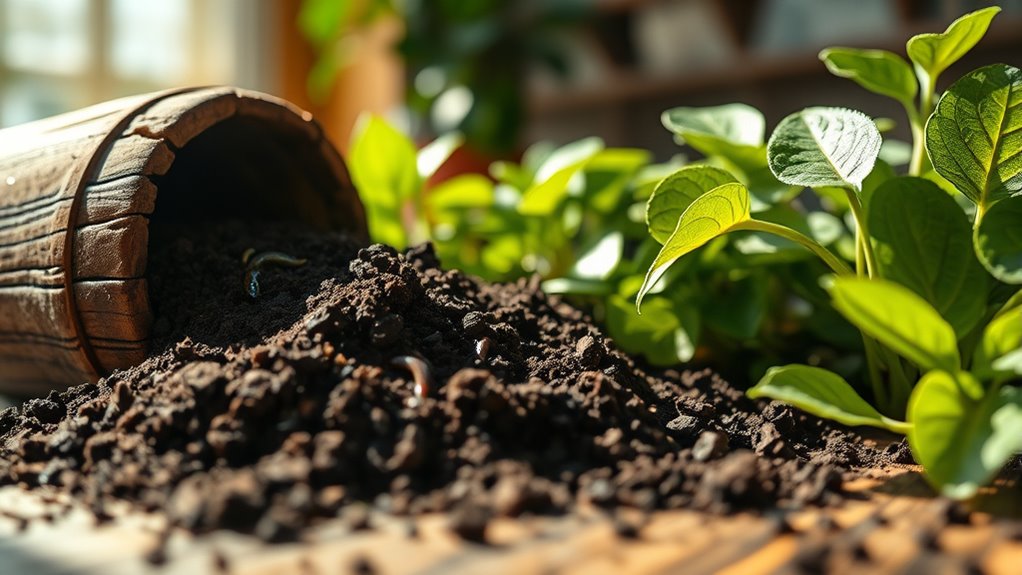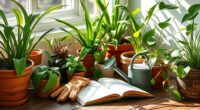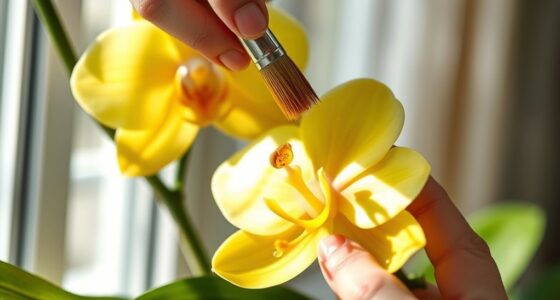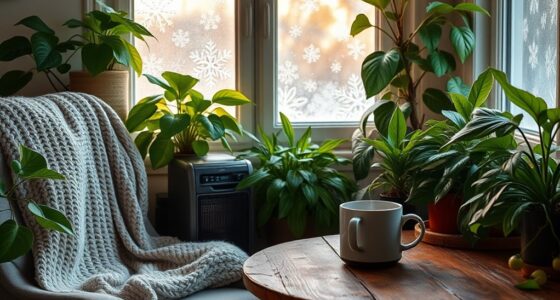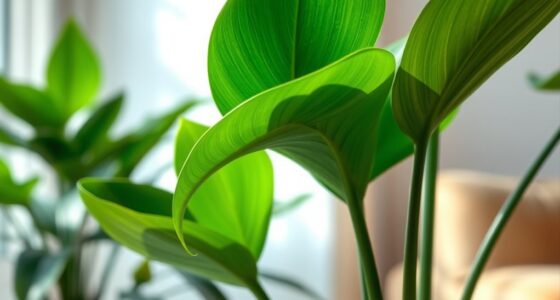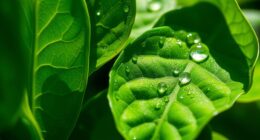Using garden soil for indoor plants isn’t a great idea. It can harbor pests, diseases, and weed seeds that threaten your indoor plants. Plus, it often has poor drainage, increasing the risk of root rot. Instead, opt for potting soil specifically designed for indoor use, which offers better aeration and a balanced nutrient profile. If you want to discover more about soil options and how to customize them, keep exploring further.
Key Takeaways
- Using garden soil indoors can introduce pests and diseases harmful to your indoor plants.
- Garden soil may contain weed seeds that compete with your indoor plants for resources.
- Its density can lead to poor drainage, increasing the risk of root rot and compaction.
- Nutrient imbalances and unsuitable pH levels in garden soil can hinder plant growth.
- Handling garden soil poses potential health risks, including exposure to harmful bacteria.
Understanding Garden Soil Characteristics
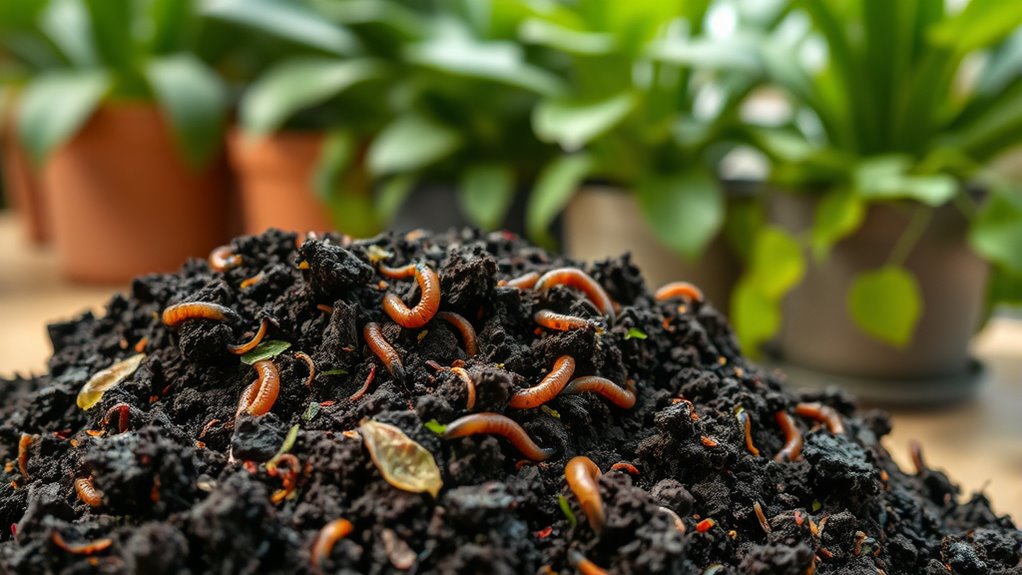
Garden soil is a complex mixture that plays a crucial role in plant health. It typically consists of sand, silt, and clay, which influence drainage and nutrient retention. You’ll notice that garden soil often contains organic matter like compost or cow manure, enhancing its fertility and texture. The soil’s characteristics can vary by region, affecting pH levels and microbial populations. Sandy soil, for example, has larger particles that drain quickly but may require additional organic amendments to improve nutrient retention. The particle size directly impacts the soil’s texture, which is essential for aeration and water retention. High humus content is beneficial, as it promotes better nutrient and water retention while reducing erosion. Understanding these characteristics helps you choose the right garden soil for your plants, ensuring they thrive and grow strong. Additionally, using proper soil mixes can significantly enhance growth and health for indoor plants. For instance, incorporating high humus content can further improve nutrient and water retention in your garden soil. Careful financial planning for gardening supplies is also crucial to ensure you can maintain your indoor plants effectively.
Risks of Using Garden Soil Indoors

While using garden soil indoors might seem like a natural choice, it can introduce several risks that could jeopardize your plants’ health.
First, garden soil often harbors pests and diseases, like insects and pathogens, which can harm your indoor plants. You might also find weed seeds that compete for resources. Additionally, using bottled lemon juice can provide a consistent and safe alternative for your indoor plants, as it is free of pests and pathogens.
Additionally, garden soil’s density leads to poor drainage, increasing the risk of root rot and compaction over time. Ground soil typically contains nutrient imbalances and unsuitable pH levels, making it difficult for your plants to thrive. Furthermore, using advance directives for planning indoor gardening care can help ensure that your plants receive the right attention when you are unable to tend to them. Studies show that proper airflow around plants can enhance their growth and health.
Lastly, handling garden soil can pose health risks to you, including exposure to Legionella bacteria. Given these issues, consider safer alternatives designed for indoor planting.
Benefits of Indoor Potting Soil
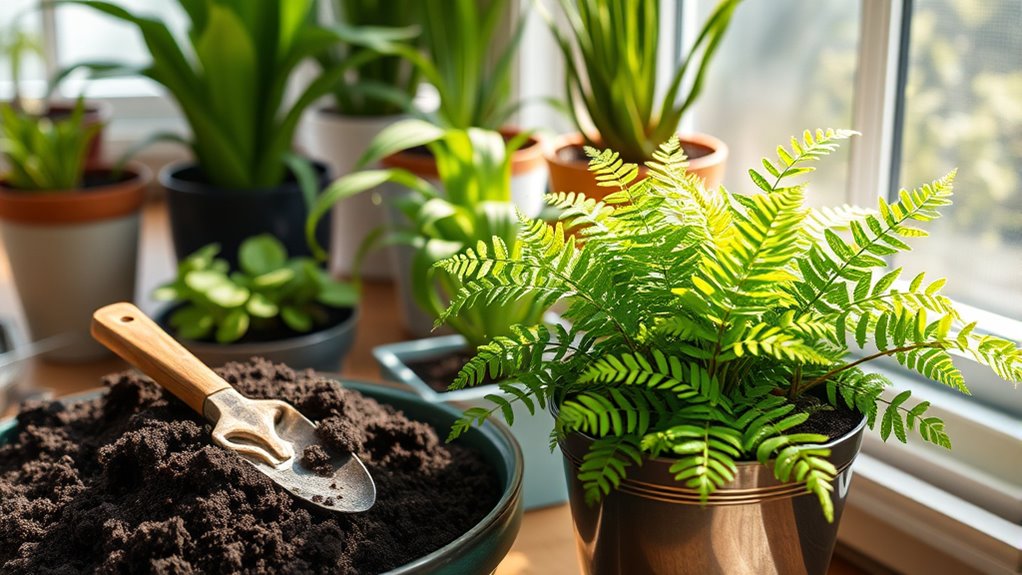
When you choose indoor potting soil for your plants, you’re investing in their health and vitality. This specially formulated soil provides excellent drainage, preventing root rot and promoting aeration, which allows more oxygen to reach the roots. You’ll notice that it reduces the chances of waterlogged soil, minimizing the risk of mold and fungal diseases. The balanced nutrient profile supports strong growth, while organic matter slowly releases nutrients for your plants. Plus, the lightweight and porous structure prevents soil compaction, enabling roots to expand freely. Indoor potting soil is designed for controlled environments, making it suitable for a variety of indoor plants. Additionally, using specialized butter tools can enhance your gardening experience by providing efficient solutions for plant care and maintenance. Regularly assessing and rotating items in your plant care routine can lead to healthier growth and a more organized gardening space. To further boost your indoor gardening success, consider the benefits of natural materials like those used in modern farmhouse decor. Whether you’re tending to succulents or ferns, indoor potting soil offers versatility and cost-effectiveness, making it a smart choice for any indoor gardener.
Types of Indoor Potting Soil
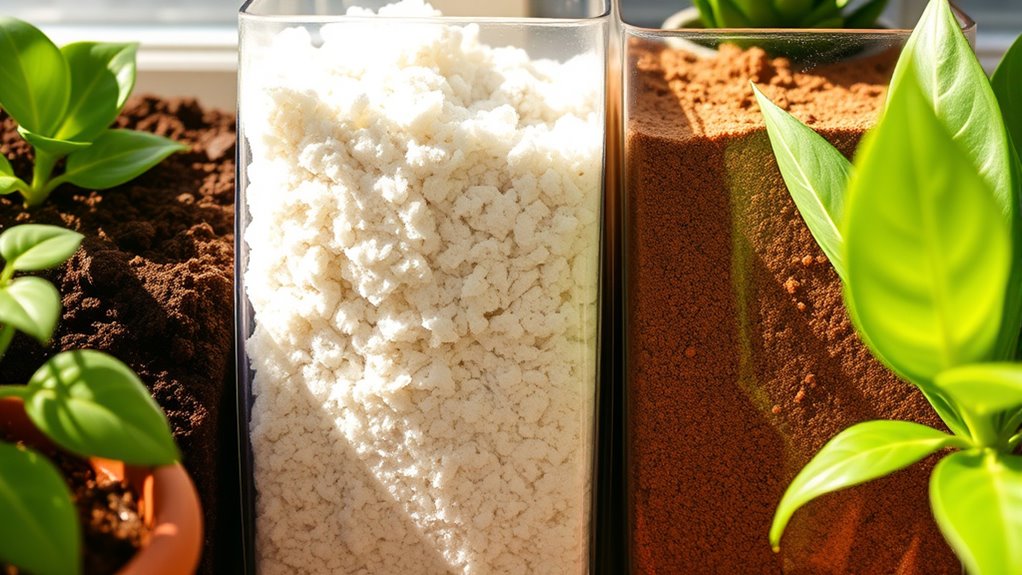
Choosing the right type of indoor potting soil can make a significant difference in your plants’ growth and overall health. You have several options to consider. Organic potting soil, made from OMRI-certified ingredients like worm castings, is great for general use and can help promote healthier weight in your indoor garden. For starting seeds, a seed starting mix offers a lightweight, soilless option with low nutrients. If you’re growing orchids, opt for an orchid potting mix with fir bark for slightly acidic conditions. Cacti and succulent soil mixes provide fast-draining properties, while African violet potting mixes ensure good drainage and aeration. Each type is designed to meet specific plant needs, so pick the one that aligns best with your indoor garden goals. Understanding different soil types is essential to ensure you select the right potting soil for your plants. Additionally, the use of educational toys can encourage children to explore gardening concepts through hands-on experiences, promoting a love for plants at an early age. Moreover, ensuring proper drainage features in your pots can prevent waterlogging and support healthy root growth.
Customizing Indoor Potting Soil
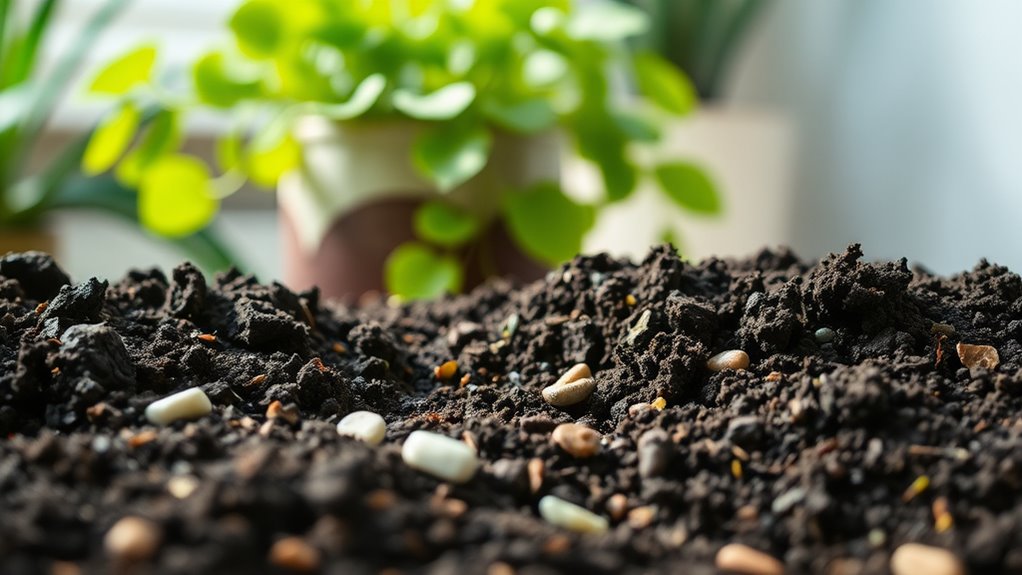
Customizing Indoor Potting Soil
Finding the right potting soil is just the beginning; customizing it can enhance your indoor plants’ growth even further.
Start with base materials like sphagnum peat moss or coco coir for moisture retention. For better drainage, mix in perlite or vermiculite. Different blends cater to various gardening needs depending on your plants, you might need specialized mixes—more sand for succulents, fine-textured mixes for seed starters, or all-purpose blends for tropical plants. Incorporating essential oils like eucalyptus or peppermint can also promote healthier growth by enhancing the soil’s microbial balance. Additionally, maintaining color accuracy in your plant care routine can lead to healthier foliage and blooms. Chia seeds, known for their high fiber content, can also be an interesting addition to homemade soil mixes for their moisture-retaining properties.
Don’t forget nutrient supplements like compost to enrich your soil. Always check pH levels; adding lime can help balance acidity.
Finally, avoid common mistakes like insufficient aeration or overfertilization. Customizing your potting soil not only saves money but ensures your plants thrive in their unique environments.
Alternatives to Garden Soil

For indoor gardeners looking to boost their plant health, garden soil isn’t always the best option. Instead, consider using sphagnum moss, which retains moisture well and is perfect for overwater-prone plants. Additionally, many indoor plants thrive in a high-efficiency substrate that supports optimal growth. Tiny houses, like the Builder Mikes Bright Tiny House, often utilize innovative designs and sustainable materials that can inspire creative gardening solutions in small spaces. Using best root lifters can also help improve overall plant vitality by promoting healthier root systems.
Coconut coir offers excellent moisture retention and improves drainage, though watch out for its high salt content. LECA helps regulate watering and provides good aeration, making it a mess-free alternative.
If you’re after improved soil aeration, perlite and vermiculite are great choices, though they require energy-intensive processing.
Lastly, incorporating biochar and mycorrhizal fungi can enhance nutrient retention and support root growth. Each of these alternatives has unique benefits that cater to different indoor plant needs, ensuring your green friends thrive indoors.
Frequently Asked Questions
Can I Mix Garden Soil With Potting Soil for Indoor Plants?
Yes, you can mix garden soil with potting soil for indoor plants, but there are some important factors to consider.
First, make sure to sterilize the garden soil to eliminate any harmful pathogens. Mixing it with potting soil can enhance nutrient content and improve drainage.
However, you’ll need to balance the nutrient levels and be cautious about compaction, which can affect your plants’ health.
Customizing the mix can work wonders for your indoor garden!
How Do I Sterilize Garden Soil for Indoor Use?
When it comes to sterilizing garden soil for indoor use, think of it as giving your soil a refreshing spa day.
You can choose from methods like steaming, oven sterilization, or microwave treatment. Each method requires you to reach a specific temperature for a set time to effectively kill pests and pathogens.
Just ensure the soil’s moisture is right, and remember to cover it post-sterilization to keep it clean until you’re ready to use it.
What Plants Can Tolerate Garden Soil Indoors?
If you’re considering plants that might tolerate garden soil indoors, you could try peace lilies, snake plants, cast iron plants, pothos, or philodendrons.
These plants are resilient and may adapt if you add proper drainage materials. However, keep in mind that even tolerant plants will thrive better in a well-draining potting mix designed for indoor environments.
It’s best to ensure they’ve the right conditions for healthy growth.
How Often Should I Water Plants in Garden Soil?
You should water plants in garden soil when the top inch feels dry. This might vary based on plant type, size, and growth rate.
Moisture-loving plants need more frequent watering, especially in warmer months. In contrast, low-water plants require less.
Keep an eye on environmental factors like light and humidity, as they also influence how often you water.
Always ensure thorough drainage to avoid root rot and maintain healthy plants.
Can Garden Soil Be Used in Raised Indoor Beds?
When it comes to using garden soil in raised indoor beds, you might be barking up the wrong tree.
Garden soil’s density and poor drainage can lead to waterlogged conditions, which isn’t ideal for your plants. It may also compact over time, stifling root growth.
Instead, consider using potting mixes or creating a custom blend that caters to your plants’ specific needs, ensuring they thrive in their indoor environment.
Conclusion
In conclusion, while garden soil may seem like a tempting treasure for your indoor plants, it’s best to stick with specialized potting mixes. These blends boast better drainage, fewer pests, and a perfect pH for your leafy companions. By choosing the right soil, you create a cozy, comfortable environment that promotes prosperous plant growth. So, say goodbye to the garden grit and embrace the bliss of balanced potting soil for thriving indoor greenery!

